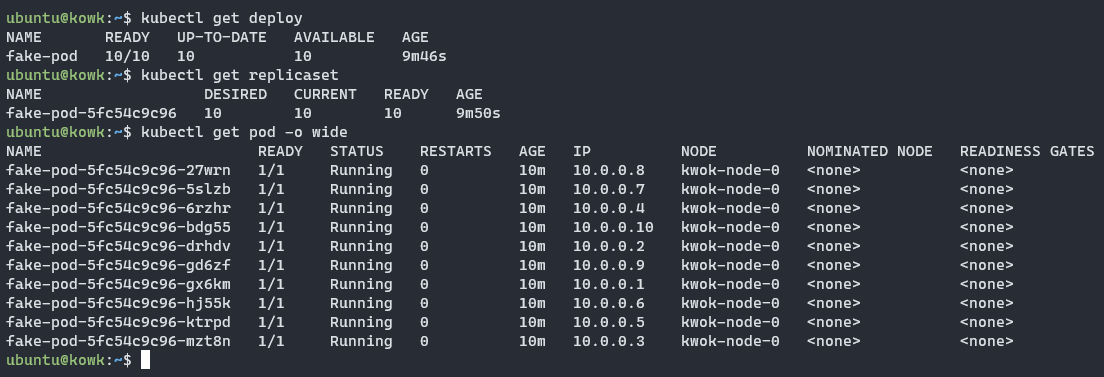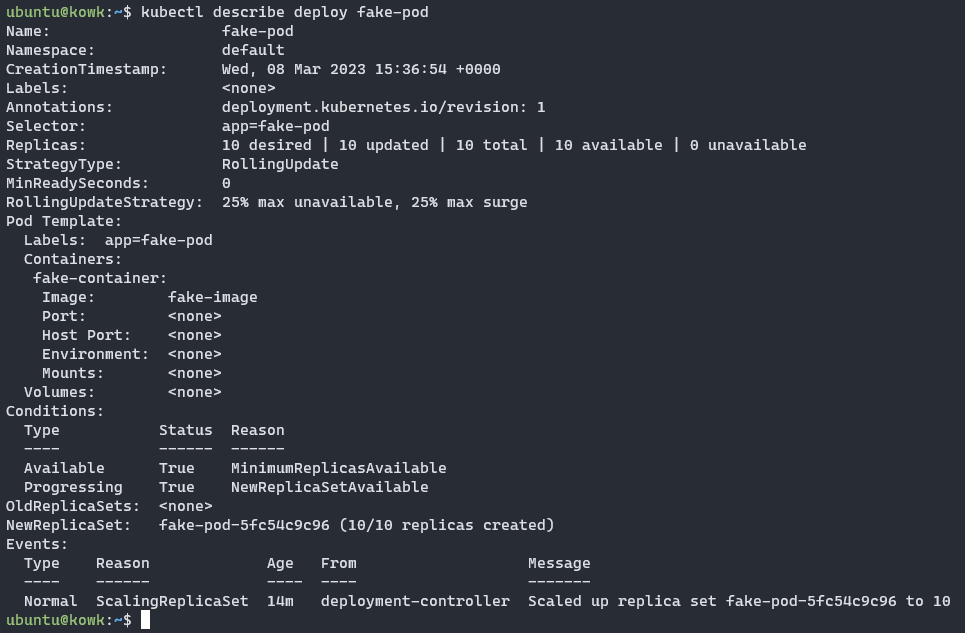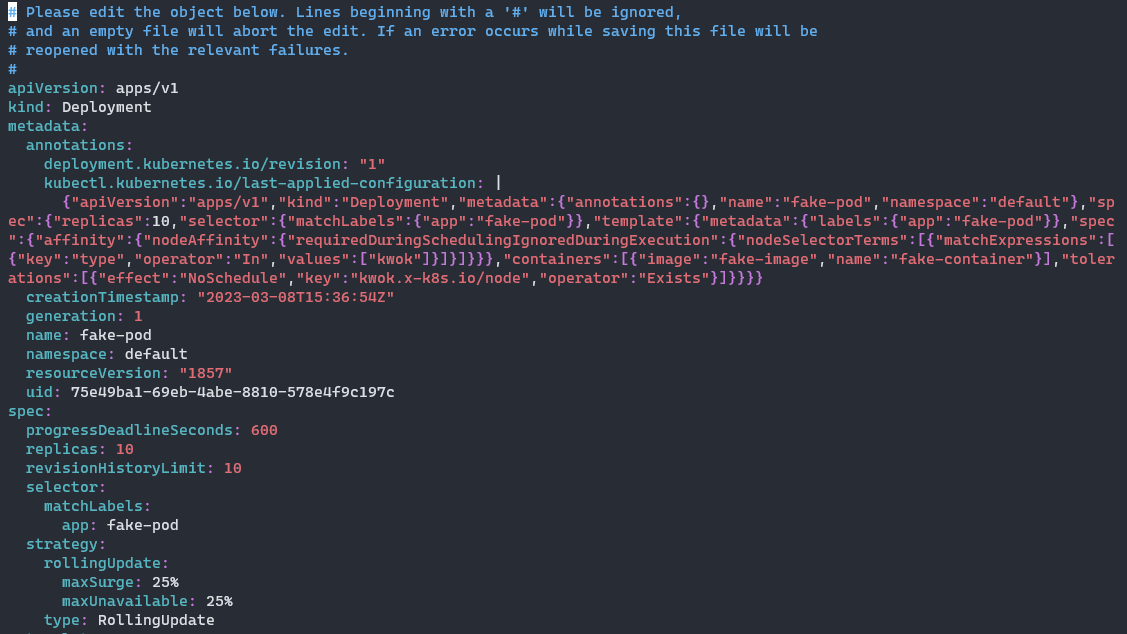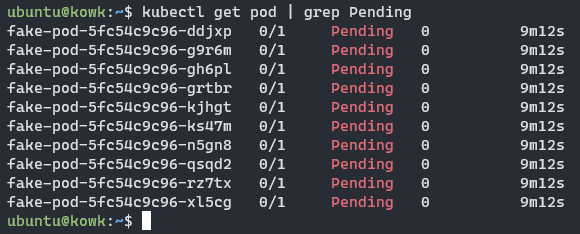Kubernetes SIGs(Special Interest Group 特別興趣小組)前陣子發布了很有趣的 K8s 模擬器 —— KWOK:Kubernetes WithOut Kubelet。
KWOK 的應用情境,開發者想要在幾秒鐘內建立一個由數千個節點組成的 Kubernetes,且模擬具有低資源佔用的真實節點,並且在不花費太多基礎設施的情況下大規模測試的 Kubernetes 控制器。
讓我們現在來體驗 KWOK 工具的安裝 & 模擬吧!
Demo 環境
本次實驗使用 CNTUG Infra Labs 的主機,有興趣的朋友可以直接到 CNTUG Infra Labs 說明文件 首頁點擊「申請 Infra Labs」。
- OS: Ubuntu 22.04
- Docker Engine: 23.0.1
- KWOK: Docker - All in one image - cluster:v1.26.0
- K8s simulate version: v1.26.0
- kubectl version: v1.26.0
前置作業
安裝 Docker
根據 Docker 官方安裝教學:
1
2
| curl -fsSL https://get.docker.com -o get-docker.sh
sudo sh get-docker.sh
|
安裝完後就可以直接使用了,但如果不想前面一直打 sudo,就加入以下命令。
1
| sudo usermod -aG docker $USER
|
最後再 logout 重新登入就可以了。
安裝 kubectl
kubectl 是一個命令列工具,用於操作 Kubernetes 集群,使用下列步驟安裝 kubectl 。
1
2
3
4
5
6
7
| curl -LO https://dl.k8s.io/release/v1.26.0/bin/linux/amd64/kubectl
curl -LO https://dl.k8s.io/v1.26.0/bin/linux/amd64/kubectl.sha256
echo "$(cat kubectl.sha256) kubectl" | sha256sum --check
sudo install -o root -g root -m 0755 kubectl /usr/local/bin/kubectl
rm kubectl*
|

使用 kubectl 指令測試版本,確認 kubectl 安裝成功。
啟動 KWOK
1
| docker run --rm -it -d -p 8080:8080 registry.k8s.io/kwok/cluster:v1.26.0
|

用 docker ps -a 確認服務是不是有啟動成功

確認沒問題後就可以依照官方教學開始實驗模擬。
實驗模擬
建立完成後,就可以用 kubectl 查看資源。
1
2
3
| kubectl get node -o wide
kubectl get pod -A
kubectl get svc -A
|

但目前裡面是沒有任何內容,為了要模擬 K8s 狀況,要先加入新節點。
KWOK 新增節點
輸入以下命令就可以新增節點。(註:這裡是根據 KWOK 官網加入節點的教學,實際上 K8s 不會這樣新增節點,特此注意。)
1
2
3
4
5
6
7
8
9
10
11
12
13
14
15
16
17
18
19
20
21
22
23
24
25
26
27
28
29
30
31
32
33
34
35
36
37
38
39
40
41
42
43
44
| kubectl apply -f - <<EOF
apiVersion: v1
kind: Node
metadata:
annotations:
node.alpha.kubernetes.io/ttl: "0"
kwok.x-k8s.io/node: fake
labels:
beta.kubernetes.io/arch: amd64
beta.kubernetes.io/os: linux
kubernetes.io/arch: amd64
kubernetes.io/hostname: kwok-node-0
kubernetes.io/os: linux
kubernetes.io/role: agent
node-role.kubernetes.io/agent: ""
type: kwok
name: kwok-node-0
spec:
taints: # Avoid scheduling actual running pods to fake Node
- effect: NoSchedule
key: kwok.x-k8s.io/node
value: fake
status:
allocatable:
cpu: 32
memory: 256Gi
pods: 110
capacity:
cpu: 32
memory: 256Gi
pods: 110
nodeInfo:
architecture: amd64
bootID: ""
containerRuntimeVersion: ""
kernelVersion: ""
kubeProxyVersion: fake
kubeletVersion: fake
machineID: ""
operatingSystem: linux
osImage: ""
systemUUID: ""
phase: Running
EOF
|
新增後會顯示 node/kwok-node-0 created。
確認 Node 有進入 Ready。
1
| kubectl get node -o wide
|

新增 Deployment
這裡我們來嘗試加入一些 Pod 到 KWOK 裡面。
1
2
3
4
5
6
7
8
9
10
11
12
13
14
15
16
17
18
19
20
21
22
23
24
25
26
27
28
29
30
31
32
33
34
35
| kubectl apply -f - <<EOF
apiVersion: apps/v1
kind: Deployment
metadata:
name: fake-pod
namespace: default
spec:
replicas: 10
selector:
matchLabels:
app: fake-pod
template:
metadata:
labels:
app: fake-pod
spec:
affinity:
nodeAffinity:
requiredDuringSchedulingIgnoredDuringExecution:
nodeSelectorTerms:
- matchExpressions:
- key: type
operator: In
values:
- kwok
# A taints was added to an automatically created Node.
# You can remove taints of Node or add this tolerations.
tolerations:
- key: "kwok.x-k8s.io/node"
operator: "Exists"
effect: "NoSchedule"
containers:
- name: fake-container
image: fake-image
EOF
|
Deployment 建立成功後,會顯示下列輸出: deployment.apps/fake-pod created
建立完成後,列出 Deployment、ReplicaSet 和所有 Pod。
1
2
3
| kubectl get deployment
kubectl get replicaset
kubectl get pod
|

看起來沒問題,連 ReplicaSet 都可以模擬呢!
也可以試著 describe deployment。
1
| kubectl describe deploy fake-pod
|

describe 出來的內容很實際呢,下一段來編輯看看 Deployment。
編輯 Deployment
模擬工具可以模仿多個 Pod 做 scale up 情況,那我們就來嘗試看看!
1
| kubectl edit deploy fake-pod
|

就把 .spec.replicas 調到 120 個看看。

編輯完成後退出,成功就會顯示 deployment.apps/fake-pod edited,來看看有沒有產生成功。
1
2
| kubectl get deployment
kubectl get replicaset
|

這裡顯示為 110 個 READY,就代表是沒有問題的,因為單節點 Pod 數量建議上限為 110 個。
如果回去看前面建立節點的步驟,.status.allocatable.pods 也是寫上 110。
也可以搭配 grep 看一下 Pending 的 Pod。
1
| kubectl get pod | grep Pending
|

刪除 Deployment
1
2
| kubectl delete deployment fake-pod
kubectl get pod -A
|

停止 KWOK
最後就把 KWOK 的 container 停止就好。
1
2
| docker ps -a
docker stop <CONTAINER ID>
|

總結
目前這樣初步玩下來覺得 KWOK 是還蠻不錯的模擬器,這樣測下來結果該有的都有,這工具個人覺得蠻適合剛入門 K8s 的人,或者想測試一些多節點的特殊玩法,不用怕測失敗把整個環境搞爛花時間重建,如果想要模擬上千節點情況也不需要昂貴的硬體設備。
真要說唯一缺點的話,CrashLoopBackOff 是不會出現的,沒辦法讓新手體驗地獄,真的有點可惜,但畢竟是 K8s WithOut Kubelet,背後是不會跑真正的 container,沒有辦法模擬出也是很正常的。
致謝
本篇感謝 CNTUG 的 Infra Labs 提供使用還有 Ader Fu 協助潤稿、校對,同步發佈在 CNTUG Infra Labs 說明文件。
喜歡這篇文章可以幫我按個 LIKE 跟訂閱 RSS 追蹤,那就下篇文章見!













